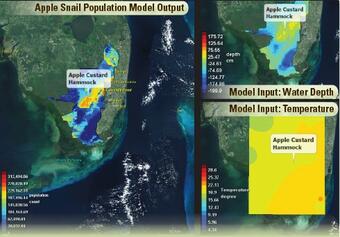EverSnail, developed in collaboration with the University of West Florida, is an age- and size-structured spatially-explicit landscape model of native apple snails (Pomacea paludosa).

The Science Issue and Relevance: Joint Ecosystem Modeling (JEM), a partnership among federal and state agencies, universities, and other organizations, is a long-term project for developing ecological models for Florida’s Greater Everglades ecosystem. Water managers and other decision-makers use ecological models to understand how competing restoration scenarios may impact species of concern and make more informed restoration decisions. JEM provides ecological model output tailored to management decisions. The federally endangered Everglades snail kite (Rostrhamus sociabilis) has an almost exclusive diet of freshwater apple snails. EverSnail, developed in collaboration with the University of West Florida, is an age- and size-structured spatially-explicit landscape model of native apple snails (Pomacea paludosa). Both snail kite and native apple snail populations have been in decline but are critical to the integrity of the Greater Everglades.
Methodology for Addressing the Issue: EverSnail provides age-structured estimates of population density and abundance. The software provides a graphical user interface (GUI) that makes running the model intuitive and straight forward for managers. Model inputs are daily water depths and temperature. Model outputs are daily egg, juvenile, and adult apple snail population provided in NetCDF format. Model parameters can be adjusted as needed, or as additional information becomes available. The model is available at jem.gov.
Future Steps: Managers and other decision-makers in the Greater Everglades can use the EverSnail population model to examine how hydrologic conditions of alternative restoration scenarios affect apple snail population dynamics. Competing water management plans may lead to differences in the abundance and distribution of apple snails, which in turn impact keystone predators, such as the snail kite. By using EverSnail, water managers can use output to optimize hydrologic conditions for wetland conservation.

Related Project(s): Joint Ecosystem Modeling (JEM), Everglades Forecasting (EVER4CAST), EverKite

Below are other science projects associated with this project.
Joint Ecosystem Modeling: Cape Sable Seaside Sparrow Marl Prairie Indicator
Joint Ecosystem Modeling: Alligator Production Probability Model
Joint Ecosystem Modeling: Greater Everglades Modeling Decision Support Tools
Below are data or web applications associated with this project.
Joint Ecosystem Modeling (JEM) Support Joint Ecosystem Modeling (JEM) Support
EverSnail, developed in collaboration with the University of West Florida, is an age- and size-structured spatially-explicit landscape model of native apple snails (Pomacea paludosa).

The Science Issue and Relevance: Joint Ecosystem Modeling (JEM), a partnership among federal and state agencies, universities, and other organizations, is a long-term project for developing ecological models for Florida’s Greater Everglades ecosystem. Water managers and other decision-makers use ecological models to understand how competing restoration scenarios may impact species of concern and make more informed restoration decisions. JEM provides ecological model output tailored to management decisions. The federally endangered Everglades snail kite (Rostrhamus sociabilis) has an almost exclusive diet of freshwater apple snails. EverSnail, developed in collaboration with the University of West Florida, is an age- and size-structured spatially-explicit landscape model of native apple snails (Pomacea paludosa). Both snail kite and native apple snail populations have been in decline but are critical to the integrity of the Greater Everglades.
Methodology for Addressing the Issue: EverSnail provides age-structured estimates of population density and abundance. The software provides a graphical user interface (GUI) that makes running the model intuitive and straight forward for managers. Model inputs are daily water depths and temperature. Model outputs are daily egg, juvenile, and adult apple snail population provided in NetCDF format. Model parameters can be adjusted as needed, or as additional information becomes available. The model is available at jem.gov.
Future Steps: Managers and other decision-makers in the Greater Everglades can use the EverSnail population model to examine how hydrologic conditions of alternative restoration scenarios affect apple snail population dynamics. Competing water management plans may lead to differences in the abundance and distribution of apple snails, which in turn impact keystone predators, such as the snail kite. By using EverSnail, water managers can use output to optimize hydrologic conditions for wetland conservation.

Related Project(s): Joint Ecosystem Modeling (JEM), Everglades Forecasting (EVER4CAST), EverKite

Below are other science projects associated with this project.
Joint Ecosystem Modeling: Cape Sable Seaside Sparrow Marl Prairie Indicator
Joint Ecosystem Modeling: Alligator Production Probability Model
Joint Ecosystem Modeling: Greater Everglades Modeling Decision Support Tools
Below are data or web applications associated with this project.




